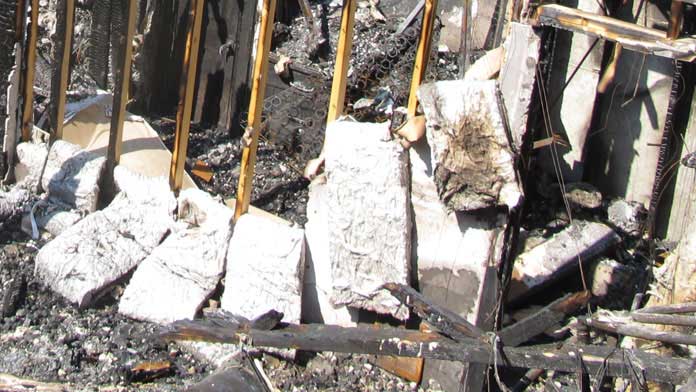If you have a chemical inhalation burn, you may have a lawsuit against the company responsible for your injuries. Attorney Eric Hageman helps people like you who have been injured in a fire or explosion. He has obtained many large money settlements for his clients. Contact Eric or another burn attorney at our law firm about your case by calling 1-888-377-8900 (toll free) or by using the form below.

What are Chemical Inhalation Injuries?
Chemical inhalation injuries are highly varied and completely dependent on the toxin causing the injury, the concentration inhaled, and the length of exposure. The size of the particles inhaled also affects the type of injury. Larger particles remain in the nasopharynx and major airways. Small particles that can diffuse easily can move into smaller airways and alveoli, potentially causing more severe damage than larger particles.

The particles themselves usually do not cause damage directly, but toxic chemicals produced by the fire can dissolve into water on the particle. The solubility of the chemicals also can affect the location of the injury. For example, HCl and SO2 are highly soluble gases when produced by fires. Because they are so soluble, they can quickly irritate major airways. But less soluble chemicals such as nitrogen dioxide and phosgene are much less soluble and affect areas deeper into the lungs.
For your lawsuit, it may be necessary to hire medical and scientific experts to testify regarding the cause of your chemical inhalation burn and how it has affected your life. Information gathered at the scene of a fire or explosion and your medical records can provide evidence needed to sue the responsible company.
Toxins in the Smoke Can Cause a Chemical Burn
The following are various toxic chemicals released in fires and their sources1:
- Carbon monoxide – All organic materials
- Hydrogen cyanide – Polyurethane, wool, silk, paper
- Acrolein (aldehydes) – Wood, acrylics, cotton, rubber
- Nitrogen Dioxide – Cellulose, wood
- Ammonia – Nylon, wood, silk, polyurethane
- Hydrogen chloride – Polyvinyl chloride (PVC pipes), upholstery
- Hydrogen fluoride – Teflon
- Hydrogen bromide – Fire retardants
- Sulfur dioxide – Rubber
- Isocyanates – Polyurethane, wool, silk, paper
- Acrylonitrites – Polyurethane, wool, silk, paper
- Hydrogen sulfide – Wool, silk, rubber
- Benzene – Petroleum-based plastics
- Styrene – Polystyrene
- Phsogene – Polyvinyl chloride (PVC).
Effects of Chemical Inhalation Burns
Because each toxin is different, each chemical burn is unique. But there are certain common effects of inhaled toxins. Aldehydes, resulting from the burning of wood, acrylics, cotton, and rubber, easily bind to small particles and penetrate deep into small airways. There they can cause constriction of the brochi, swelling of lung tissue, and sloughing of the mucous membrane (the tissue is dead, so it falls off).
Most inhalation injuries result in direct damage to the respiratory epithelium (tissue similar to skin). This can cause an increase in mucus production, reduced function, and cell death. If the exposure is long enough or toxins present in high concentrations, sloughing of the epithelium occurs (it falls off). This can in turn cause airway blockage.
In addition to the damage directly caused by the toxins, our immune response can contribute to tissue damage. Neutorophils (phagocytic white blood cells) accumulate in the area damaged by the toxin and attempt to remove the toxins. But during the digestion process, neutrophils release free radicals and other strong digestive chemicals which can compound damage caused by the toxins.
The major effects of this immune response are low oxygen levels (hypoxia) and ventilation/perfusion (V/Q) mismatch (incorrect ratio of oxygen breathed in to amount in the blood). These result from tissue destruction, which in turn can clog the small airways. The immune response can also result in loss of mucous function. Mucous is used in the respiratory tract to remove particles, so loss of function causes further clogging of the airway and eventual lung collapse (atelectasis).
Your chemical inhalation burn lawsuit needs to seek enough money to compensate you for all of the harm that you have suffered and will suffer into the future. Because of this, it is important to hire an attorney with fire and explosion lawsuit experience.
Chemical Inhalation Treatment
To prevent damage caused by our immune response, depletion of leukocytes, oxygen-free radical scavengers, and cyclooxygenase inhibitors have been shown to be partially effective.
However, there are typically no specific treatments for inhalation injury caused by chemicals; usually only support treatment is used. Swelling of the airways which can cause difficulty breathing is common; aerosolized epinephrine (adrenalin) is used to decrease swelling. If swelling is severe enough, an endotracheal tube may need to be used to prevent airway closure.
Other support measures are taken to relieve other symptoms such as excess secretions that can cause airway blockage. Common treatment methods include airway suctioning (using a catheter) and therapeutic coughing to remove obstructions. If injuries are severe enough, fiberoptic brochoscopy may be needed to directly remove blockages.
If no other therapies are effective in causing respiratory failure, mechanical ventilation may be necessary. But mechanical ventilation itself has been shown to cause damage.
Source: Carrougher, Gretchern J. (1998). Burn Care and Therapy. St. Louis: Mosby Inc.